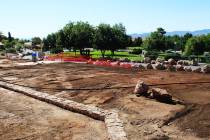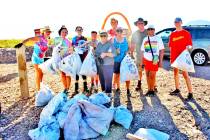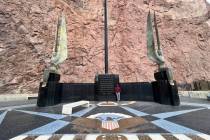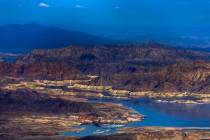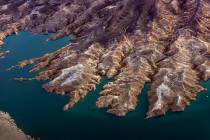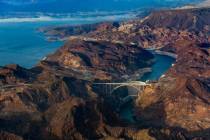Lake Mead dips to lowest level in decades
Lake Mead’s water level continues to drop to a record low, with staggering numbers that have rarely been seen since it began filling up nearly 80 years ago.
Despite a slight increase expected in the water supply by the end of the year, the dry winters in the Rocky Mountains continue to plague the nation’s biggest reservoir.
According to the Bureau of Reclamation, Lake Mead reached as low as 1,081.68 feet Monday at 9 p.m., about 39 percent full. The last time it was that low, the year was 1937. Franklin Roosevelt was president of the United States, a new house in Texas cost $4,100 and Margaret Mitchell won a Pulitzer Prize for her book “Gone With the Wind.”
The decrease in the water level has been the result of excessively arid winters in 2012 and 2013, and it’s caused Lake Mead to drop approximately 51 feet since December 2012, according to the Bureau of Reclamation.
But even after a surprisingly good winter in which the lake is expected to gain 2 feet by the beginning of next year, it’s not enough to fix the wound that’s already been brought forth by Mother Nature.
“It’s not going to make up for the last two years, because we’d basically been staying even,” said bureau spokesperson Rose Davis.
The lake reached the 1,081.94 mark back in November 2010, but wetter winters elevated the lake to 1,132 feet by the end of 2011.
Lake Mead is expected to gain anywhere from 8.2 million to 9 million acre-feet of water by the end of the year, Davis said. Each acre-foot represents 325,851 gallons of water.
The Colorado River Compact of 1922 divided up the river between seven states and, eventually Mexico in 1944, breaking them up into two sections. Wyoming, Utah, New Mexico and Colorado were tagged as the upper basin, while California, Nevada and Arizona were designated as the lower basin.
Each state was given a certain amount of water based on its agriculture, a factor that has caught up with Nevada because it’s grown leaps and bounds since the compact was signed more than 90 years ago.
According to Bronson Mack of the Southern Nevada Water Authority, the compact gave California 4.4 million acre-feet of water and Arizona was given 2.8 million acre-feet. When Mexico was added, it was given 1.5 million acre-feet. Nevada was only given 300,000, which has caused problems since the valley has greatly expanded since the original compact was signed in 1922.
“In the 1920s, Las Vegas was hardly in existence. It was a whistle stop for the railroad,” Mack said.
Although the Las Vegas Valley is now home to more than 2 million people, it is pretty much impossible for Nevada to get an increase in water distribution from Lake Mead.
“It’s really set in stone,” Mack said. “The seven basin states don’t have any immediate interest in putting the compact back on the table for litigation.”
After several years of drought, the secretary of the interior drafted interim guidelines for the operation of Lake Mead and Lake Powell in 2007. The agreement acknowledges that once Lake Mead dips to 1,075 feet, water will be tapped from Lake Powell to help Lake Mead cover its losses.
“Think of Lake Powell as a savings account for the upper basin states, because the upper basin has to ensure that the lower basin receives an allotted amount of water,” Mack said.
Lake Powell was created to store water for the upper basin states, Mack said, and the two reservoirs operated independently until 2007 when the interim operation guidelines were drafted.
The National Park Service spent $36 million from 2002-12 adjusting launch ramps and other maintenance issues during the drought, according to spokesperson Christie Vanover. Concessionaires at the lake have had to spend their own money to extend their utility lines as well.
The consistent drops in the water level are causing headaches for several agencies, and the park service is no exception.
“Every time the lake drops a foot, you gain 20 feet of shoreline,” Vanover said. “It’s created more hazards on launch ramps. It’s changed launch conditions and it’s changed the lake. Even compared to last week, it’s different.”
But efforts are ongoing to solve the problem of the decreasing water supply. Construction on a third intake tunnel are underway to make sure Southern Nevada will still have access to drinking water if the lake continues to drop.
The first tunnel is at the 1,050-foot mark, and would be inoperable if the lake were to dry up another 31 feet, according to Mack.
The second tunnel is at 1,000 feet, and the third tunnel under construction will be located at 860 feet below the lake’s surface.
According to Vanover, projections show the lake is expected to recede another 13 feet by next summer, and based on the bureau’s 24-month study, which is updated monthly, Lake Mead is projected to drop to 1,061 feet by June of 2016.
But all of that could change depending on how wet the winters are in the Rocky Mountains.
And even though the uncontrollable weather dictates whether the lake will gain more water, or gain a more notable ring, Mack remains optimistic about the minimal surplus Lake Mead will get by the end of the year.
“I think what’s important to note is that we expect the river to have 95 percent of its normal flow,” he said. “This winter has been the wettest winter we’ve seen in the past three years, and it’s coming off the two driest in back-to-back years.”
Mack also credited the water conservation of Southern Nevada residents as another positive sign, noting that Nevada would be able to cover the 13,000 acre-foot shortage the state would get if Lake Mead drops to 1,075 feet.
“Our community has already conserved enough (water) that we would absorb that shortage and nobody would feel it,” he said.
But even Mack said the authority continues to hold its breath every year, despite some encouragement from this latest run off.
Vanover echoed the sentiment.
“It’s the uncontrollable variable in our water level. We’ve been experiencing almost a 15-year drought,” she said. “If we get relief from it, then absolutely things could turn into a positive direction for us.”






